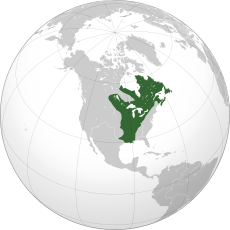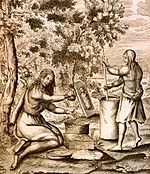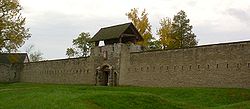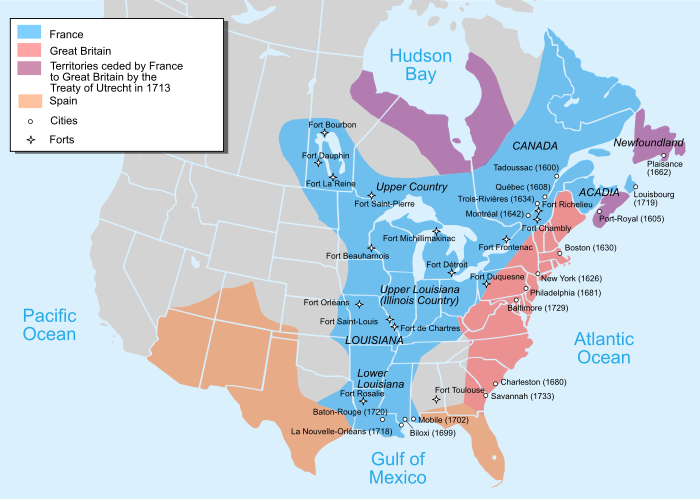- Portal:New France
-
- Wikipedia portals:
- Culture
- Geography
- Health
- History
- Mathematics
- Natural sciences
- People
- Philosophy
- Religion
- Society
- Technology
Main Page Topics Port-Royal Pub Welcome to the New France portal. This Wikipedia portal aims to provide easy access to all Wikipedia articles relating to the history of New France. You will find below both a featured article, a biography, a location and an image related to New France. The topics tab presents a selection of articles, the most exhaustive possible, dealing with the realities of the French colonization of North America and classified by topic.
New France (1534 - 1763)
New France is the name that France gave to its colonies in North America. The history of New France began with the first attempts at French colonization following the first trip of Jacques Cartier in 1534.From 1604 to 1760, the Kingdom of France gradually expanded its authority over lands inhabited and sometimes settled by Native American populations. Samuel de Champlain founded the town of Quebec on July 3, 1608. It is one of the first permanent European settlements in North American soil and it was the capital of New France for over a century and a half.
This vast territory spanned three distinct regions: Acadia, in what is now Atlantic Canada and part of North Eastern United States, Canada, then comprising only St. Lawrence valley, and Louisiana, which included the Illinois Country, comprising the Mississippi and Ohio river valleys down to the Gulf of Mexico. New France had a low population growth compared to the British American colonies adjacent to its eastern borders. Around 1730, the gap was considerable: the British colonies had about 250,000 people of European origin while there were only 30,000 people in New France.
This, in addition to its geographical position preventing the expansion of the British colonies, triggered confrontations. Those became more frequent until the fall of Quebec on September 13, 1759. A year after its capital was captured, New France fell and was dismantled. Parts were ceded to Great Britain while the rest went to Spain.
New France ceased to exist in 1763 when France ceded Canada and its dependencies to Great Britain by signing the Treaty of Paris. Then in 1800, Napoleon Bonaparte returned the vast Louisiana region to France from Spain under the Treaty of San Ildefonso. However, the treaty was kept secret, and Louisiana remained under Spanish control until a transfer of power to France on November 30, 1803, just three weeks before the cession to the United States under the Louisiana Purchase. Today, all that remains to France of this once vast wilderness empire are the little islands of Saint-Pierre et Miquelon, located off Newfoundland, Canada.
" To quickly forget
a blessing is
the vice of the French. "Selected article -
The economy of the Iroquois originally focused on communal production and combined elements of both horticulture and hunter-gatherer systems. The tribes of the Iroquois Confederacy and other Northern Iroquoian-speaking peoples, including the Huron, lived in the region including what is now New York State and the Great Lakes area. The Iroquois Confederacy was composed of five different tribes — a sixth was added later — who had banded together shortly before European contact. While not Iroquois, the Huron peoples fell into the same linguistic group and shared an economy similar to the Iroquois. The Iroquois peoples were predominantly agricultural, harvesting the "Three Sisters" commonly grown by Native American groups: maize, beans, and squash. They developed certain cultural customs related to their lifestyle. Among these developments were ideas concerning the nature and management of property.
The Iroquois developed a system of economics very different from the now dominant Western variety. This system was characterized by such components as communal land ownership, division of labor by gender, and trade mostly based on gift economics.
Contact with Europeans in the early 1600s had a profound impact on the economy of the Iroquois. At first, they became important trading partners, but the expansion of European settlement upset the balance of the Iroquois economy. By 1800 the Iroquois had been confined to reservations, and they had to adapt their traditional economic system. In the 20th century, some of the Iroquois groups took advantage of their independent status on the reservation and started Indian casinos. Other Iroquois have incorporated themselves directly into the outside economies off the reservation.
Selected picture -
Fort de Chartres is a French post, built in 1720 near the Mississippi. It was an administrative center of the Illinois Country in New France, particularly in Louisiana. Two forts that preceded it were near the same name: they were built at the beginning of the 1700s. Did you know?
- ...On July 3, 2008, Quebec City celebrated its 400th birthday! It was the first city founded by Europeans in North America, always on the same site. All year 2008 is devoted to festivities.
- ...The Battle of Quebec occurred on October 16, 1690 between the British and French forces. When the British sent a request for the city to surrender, Frontenac replied "I have no reply to make to your general other than from the mouths of my cannons and muskets.". This legendary response, and a poor assessment of the fortifications by the British, allowed France to keep Quebec for almost another seventy years.
- ...During the Great Upheaval of the Acadians in 1755, seventy-eight survivor families settled on Belle Île in France while the British took possession of French colonies in America. Since then, their descendents have remained on the island. Today most islanders have Acadian ancestry.
Selected biography -
Jean Talon, Comte d'Orsainville (1625, baptised 8 January 1626 – November 1694) was a French colonial administrator who was the first and most highly regarded Intendant of New France under King Louis XIV.
He was born at Châlons-en-Champagne, to Philippe Talon and Anne de Bury in 1625. He was very entrepreneurial and as Intendant during 1665–1672, he attempted to diversify the colony's economy by encouraging agriculture, fishing, lumbering, and industry as well as the traditional fur trade. He approved Robert La Salle's plan to mount expeditions to seek a western passage to China. As the first intendant to arrive in New France, his mission was to boost the growth and prosperity of the remote colony by making it self-sufficient.
Selected location -
Québec or Quebec City, also Quebec City or Québec City (French: Québec, or Ville de Québec), is the capital of the Canadian province of Quebec and is located within the Capitale-Nationale region. It is the second most populous city in the province – after Montreal, about 233 kilometres (145 mi) to the southwest. Quebec City is one of the oldest European settlements in North America.
Quebec was founded by Samuel de Champlain on 3 July 1608 at the site of a long abandoned St. Lawrence Iroquoian settlement called Stadacona. It was to this settlement that the name "Canada" refers. Although called the cradle of the Francophone population in North America, the Acadian settlement at Port-Royal antedates it. The place seemed favourable to the establishment of a permanent colony.
Timelines of New France history
For the detailed chronology of this epic of New France, simply visit this
 Timeline of New France history.
Timeline of New France history.Categories
To display all subcategories click on the [+] Related portals
Acadia Canada France United Kingdom Colonialism United States Louisiana Illinois Quebec Military history
of FranceKingdom
of FranceHistory
of CanadaWikiProjects
Canada History European history Former countries United States Saint Pierre
and MiquelonAssociated Wikimedia
Purge server cache Categories:- New France
- History portals
- North American portals
Wikimedia Foundation. 2010.











